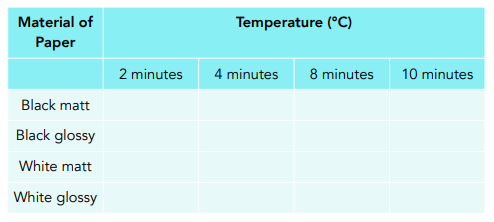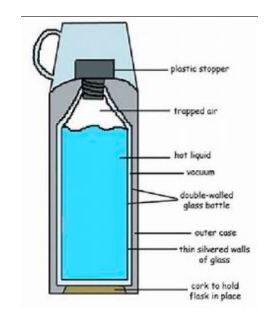Thermal Radiation (GCSE Physics)
Thermal Radiation
Radiation
Radiation involves transfer of heat via infra red waves, unlike thermal conduction and convection which need the vibration or movement of particles.
This means radiation can occur in a vacuum, where there are no particles of matter. The sun provides heat to the earth due to radiation.
An object can absorb radiation, causing the temperature of the object to rise. However it can also partly reflect or transmit radiation.
Some surfaces are better at absorbing and emitting heat radiation than others. This can be investigated using boiling tubes covered in different surface materials.
Investigating Thermal Radiation
Method
- Gather the equipment. For this experiment, you will need boiling tubes, a kettle, test tube rack, various paper of different materials, rubber bungs, a timer and a thermometer.
- Assemble the equipment. Place the test tubes in a test tube rack. Cover each tube in the same area of paper but of the following different surfaces.
- Black matt paper
- Black paper with a glossy surface
- White matt paper
- White paper with a glossy surface
- Fill the tubes. Fill each tube with hot boiling water.
- Check the temperature. Using the thermometer, check the temperature of the water in each tube and record your results.
- Start the timer. Lightly seal each tube with a rubber bung and start the timer.
- Record the temperature as it decreases. Every two minutes remove the rubber bung and record the temperature of the water.
- Repeat. Repeat this process until ten minutes have passed and record your final temperature.
- Record your results in a table. The results table should look like this:

Examples of Thermal Radiation
- Clothing in hot weather. In countries with a warm climate, people are recommended to wear white clothing instead of black. This means you’ll absorb less heat and stay cooler for longer.
- Foxes. Foxes with white fur are better adapted to survive in cold conditions compared to foxes with brown fur. Their white fur reduces the amount of heat radiated, so they can retain more heat to survive the cold weather.
Heat Transfer
Forms of Heat Transfer
We have now covered the main forms of heat transfer (conduction, convection and radiation).

However, sometimes we want to reduce the amount of heat transfer. A great example to illustrate this is a vacuum flask. A vacuum flask has many adaptions to reduce energy transfer via conduction, convection and radiation.
Vacuum Flask
- Silvered surfaces. These surfaces reflect any infrared radiation back towards the hot liquid. The silverly surface is also a poor emitter of radiation, so less heat is lost to the surroundings.
- Plastic stopper. Plastic is a poor conductor and insulator of heat, reducing thermal conduction. This also stops convection currents from forming at the top of the flask, reducing energy transfer by convection.
- Vacuum. The vacuum stops energy transfer by conduction and convection, as these processes require the movement of particles to occur.
- Glass walls. Glass is also a poor conductor of heat, reducing energy transfer by conduction.

Thermal radiation is the transfer of heat energy through electromagnetic waves, which can travel through a vacuum and do not require a material medium to transfer the energy.
Thermal radiation occurs due to the emission of electromagnetic waves from an object, which are caused by the movement of charged particles within the object. These waves can be absorbed or reflected by other objects, which can result in a transfer of heat energy.
Examples of thermal radiation in everyday life include: feeling the warmth of the sun on your skin, using an infrared thermometer to measure the temperature of an object, and feeling the heat from a fire.
The amount of thermal radiation emitted by an object is directly proportional to the fourth power of its temperature. This relationship is described by the Stefan-Boltzmann law.
The wavelength of the thermal radiation emitted by an object is inversely proportional to its temperature. This relationship is described by Wien’s law.
All objects above absolute zero temperature emit thermal radiation, including the human body, a light bulb, and a star.
A black body is an idealized object that absorbs all of the thermal radiation that falls on it, and emits thermal radiation with a spectrum that depends only on its temperature. It is often used as a theoretical model to describe the behavior of thermal radiation.
Materials that are good emitters of thermal radiation include black bodies, metals, and some non-metals such as carbon.
Materials that are poor emitters of thermal radiation include polished metals and some non-metals such as glass.
Materials that are good absorbers of thermal radiation include black bodies and materials with a rough or irregular surface.
Materials that are poor absorbers of thermal radiation include polished metals and materials with a smooth or shiny surface.





Still got a question? Leave a comment
Leave a comment